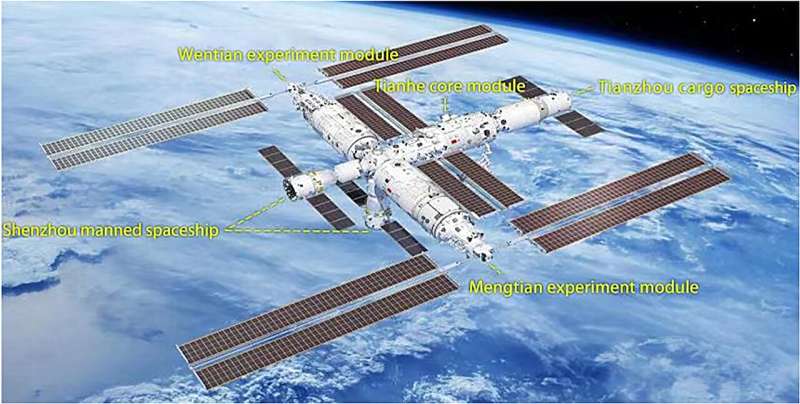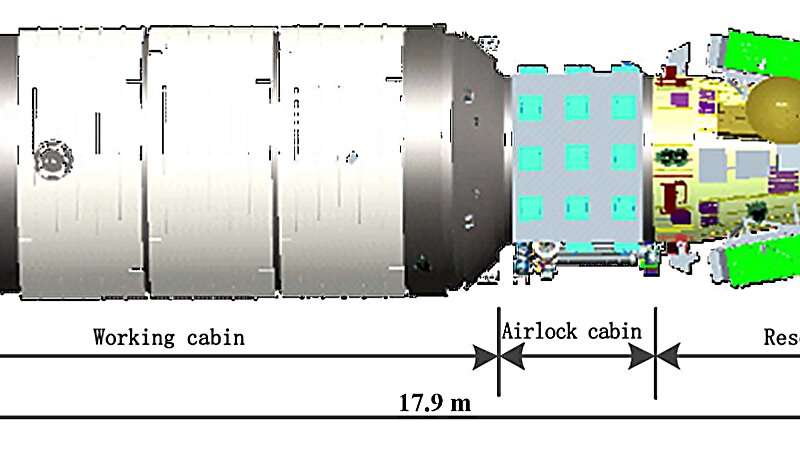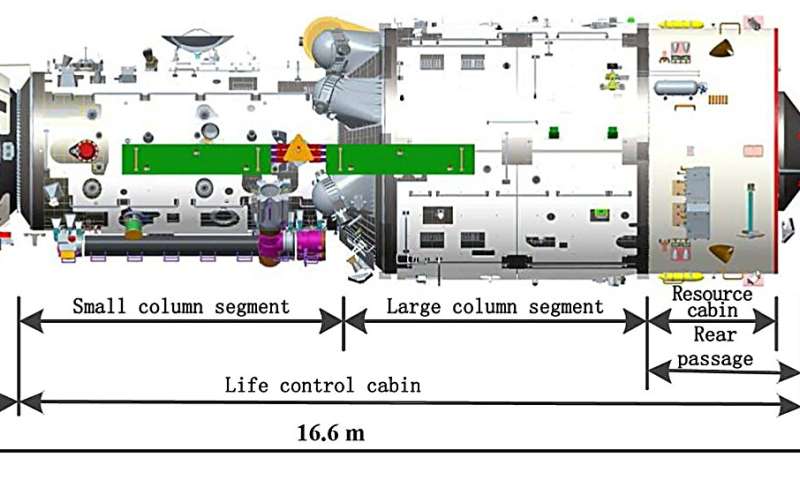by Beijing Institute of Technology Press Co., Ltd

Configuration diagram of Tiangong space station. Credit: Space: Science & Technology
China's manned space project was approved in 1992 with a three-step strategic plan, and building a space station is the final goal of this plan.
In September 2010, China's manned space station project was officially established. On April 29, 2021, the Tianhe core module was successfully launched into orbit by the carrier rocket Long March-5B at the Wenchang Spacecraft Launch Site in Hainan.
As planned, by 11 launches and on-orbit missions, China has completed the assembly and started the official operation of the space station. With the completion and operation of the Tiangong space station, China will become the third country able to build and operate space stations independently after the Soviet Union and the United States.
In a research paper published in Space: Science & Technology, specialists from Institute of Spacecraft System Engineering, China Academy of Space Technology introduce the design of the Tiangong space station, summarize the technical characteristics of the Tiangong space station, and discuss the future application and development of the space station.
First, authors introduce the system scheme design of Tiangong space station. Overall, the Tiangong space station shows a T-shaped configuration, with the Tianhe core module in the middle and two experiment modules, namely Wentian and Mengtian, being assembled on the two sides respectively.

The high proportion of new technology.
Space robotic arms, physicochemically regenerative life support, and the large-area flexible solar arrays of this space station are all brand-new technologies applied in orbit for the first time in China with high application difficulty and development risk. Additionally, the Tiangong space station embodies a high degree of intelligence from both equipment and system levels.
The excellent cost-effectiveness ratio.
In line with China's national conditions and practical needs in terms of building costs and application benefits, the Tiangong space station is designed to be moderate scale, relative to the ISS and Mir. Moreover, having more economical and reasonable construction and operation, it will be superior in some aspects, such as the power generation efficiency, application support capability, building ways, replenishment demand.
The safe and efficient residence.
The Tiangong space station is designed in line with the human-oriented concept. The design not only ensures the safety and comfort of the crew in orbit but also focuses on supporting the effective exertion by the crew's intelligence.
More information: Xiang Wang et al, Design and Application Prospect of China's Tiangong Space Station, Space: Science & Technology (2023). DOI: 10.34133/space.0035
Provided by Beijing Institute of Technology Press Co., Ltd
China's manned space project was approved in 1992 with a three-step strategic plan, and building a space station is the final goal of this plan.
In September 2010, China's manned space station project was officially established. On April 29, 2021, the Tianhe core module was successfully launched into orbit by the carrier rocket Long March-5B at the Wenchang Spacecraft Launch Site in Hainan.
As planned, by 11 launches and on-orbit missions, China has completed the assembly and started the official operation of the space station. With the completion and operation of the Tiangong space station, China will become the third country able to build and operate space stations independently after the Soviet Union and the United States.
In a research paper published in Space: Science & Technology, specialists from Institute of Spacecraft System Engineering, China Academy of Space Technology introduce the design of the Tiangong space station, summarize the technical characteristics of the Tiangong space station, and discuss the future application and development of the space station.
First, authors introduce the system scheme design of Tiangong space station. Overall, the Tiangong space station shows a T-shaped configuration, with the Tianhe core module in the middle and two experiment modules, namely Wentian and Mengtian, being assembled on the two sides respectively.

Configuration diagram of Wentian experiment module. Credit: Space: Science & Technology


Configuration diagram of Tianhe core module. Credit: Space: Science & Technology
The Tianhe core module consists of three parts: a node cabin, a life control cabin, and a resource cabin. It has a total axial length of 16.6 m and a maximum diameter of 4.2 m. The Wentian experiment module consists of three parts: a working cabin, an airlock cabin, and a resource cabin. It has an axial length of 17.9 m and a maximum diameter of 4.2 m.
In addition, a small robotic arm, an experimental platform, and a truss structure are arranged outside the module. The Mengtian experiment module consists of four parts: a working cabin, a cargo airlock cabin, a load cabin, and a resource cabin. It has an axial length of 17.9 m and a maximum diameter of 4.2 m.
Two deployable platforms for exposed payloads are installed outside the load cabin, unfolding in orbit after launch. Moreover, the Tiangong space station has three docking hatches: forward (mainly for docking with manned spaceship and the Xuntian space telescope), backward (mainly for docking with cargo spaceship), and radial ones (mainly for docking with manned spaceship).
As for the system function design, the control and propulsion system includes control moment gyros, a reaction control system, a propellant refueling system, and the Hall electric propulsion system. The energy system is equipped with a large area of flexible solar arrays. The manned environment system possesses complete regenerative and non-regenerative life-support systems.
The robotic arms are the large seven-degree-of-freedom robotic arm and the small seven-degree-of-freedom robotic arm, with rich sensors of visual measurement, joint torque, and end-effector force. The extravehicular activities are supported by both the node cabin of the Tianhe core module and the airlock cabin of the Wentian experiment module. The crew's residence is provided with an activity space of no less than 110 m3.
The authors then summarize technical characteristics of advanced nature. Generally, the technical characteristics of the Tiangong space station are mainly reflected in four aspects:The advanced design concept.
China adopts a unified design framework and technical system for the Tiangong space station, under which the GNC, energy, information, thermal control, and manned environment systems of all the three modules will be interconnected to work together. And, the space station integrates intermodule resources efficiently, thus improving its overall capacity and system reliability.
The Tianhe core module consists of three parts: a node cabin, a life control cabin, and a resource cabin. It has a total axial length of 16.6 m and a maximum diameter of 4.2 m. The Wentian experiment module consists of three parts: a working cabin, an airlock cabin, and a resource cabin. It has an axial length of 17.9 m and a maximum diameter of 4.2 m.
In addition, a small robotic arm, an experimental platform, and a truss structure are arranged outside the module. The Mengtian experiment module consists of four parts: a working cabin, a cargo airlock cabin, a load cabin, and a resource cabin. It has an axial length of 17.9 m and a maximum diameter of 4.2 m.
Two deployable platforms for exposed payloads are installed outside the load cabin, unfolding in orbit after launch. Moreover, the Tiangong space station has three docking hatches: forward (mainly for docking with manned spaceship and the Xuntian space telescope), backward (mainly for docking with cargo spaceship), and radial ones (mainly for docking with manned spaceship).
As for the system function design, the control and propulsion system includes control moment gyros, a reaction control system, a propellant refueling system, and the Hall electric propulsion system. The energy system is equipped with a large area of flexible solar arrays. The manned environment system possesses complete regenerative and non-regenerative life-support systems.
The robotic arms are the large seven-degree-of-freedom robotic arm and the small seven-degree-of-freedom robotic arm, with rich sensors of visual measurement, joint torque, and end-effector force. The extravehicular activities are supported by both the node cabin of the Tianhe core module and the airlock cabin of the Wentian experiment module. The crew's residence is provided with an activity space of no less than 110 m3.
The authors then summarize technical characteristics of advanced nature. Generally, the technical characteristics of the Tiangong space station are mainly reflected in four aspects:The advanced design concept.
China adopts a unified design framework and technical system for the Tiangong space station, under which the GNC, energy, information, thermal control, and manned environment systems of all the three modules will be interconnected to work together. And, the space station integrates intermodule resources efficiently, thus improving its overall capacity and system reliability.
The high proportion of new technology.
Space robotic arms, physicochemically regenerative life support, and the large-area flexible solar arrays of this space station are all brand-new technologies applied in orbit for the first time in China with high application difficulty and development risk. Additionally, the Tiangong space station embodies a high degree of intelligence from both equipment and system levels.
The excellent cost-effectiveness ratio.
In line with China's national conditions and practical needs in terms of building costs and application benefits, the Tiangong space station is designed to be moderate scale, relative to the ISS and Mir. Moreover, having more economical and reasonable construction and operation, it will be superior in some aspects, such as the power generation efficiency, application support capability, building ways, replenishment demand.
The safe and efficient residence.
The Tiangong space station is designed in line with the human-oriented concept. The design not only ensures the safety and comfort of the crew in orbit but also focuses on supporting the effective exertion by the crew's intelligence.
More information: Xiang Wang et al, Design and Application Prospect of China's Tiangong Space Station, Space: Science & Technology (2023). DOI: 10.34133/space.0035
Provided by Beijing Institute of Technology Press Co., Ltd
No comments:
Post a Comment